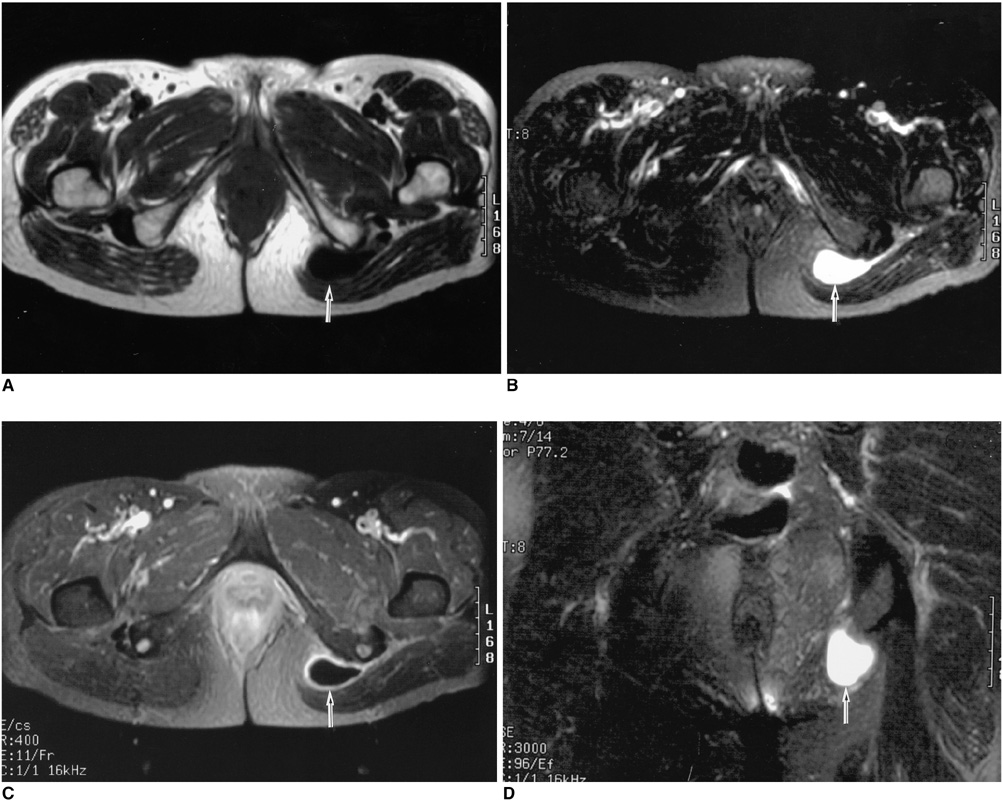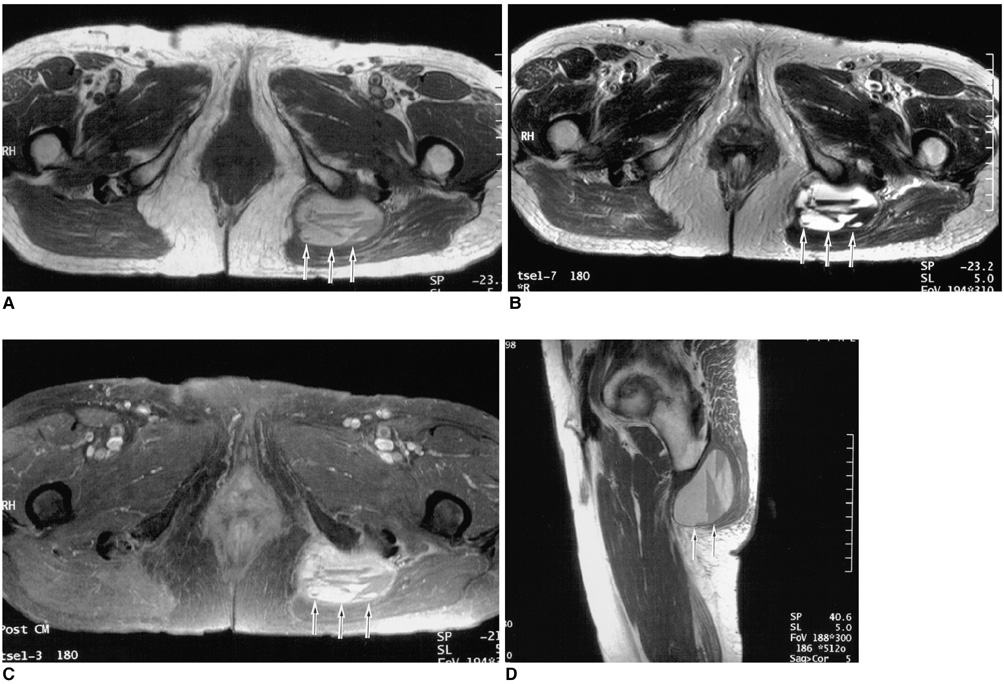Korean J Radiol.
2004 Dec;5(4):280-286. 10.3348/kjr.2004.5.4.280.
Non-Infectious Ischiogluteal Bursitis: MRI Findings
- Affiliations
-
- 1Department of Diagnositic Radiology, Yeungnam University College of Medicine, Korea. khcho.med@yumail.ac.kr
- 2Department of Diagnositic Radiology, Keimyung University College of Medicine, Korea.
- 3Department of Diagnositic Radiology, Daegu Hyosung Catholic University College of Medicine, Korea.
- 4Suh & Joo MR Clinic
- 5Department of Diagnositic Radiology, Asan Medical Center, University of Ulsan College of Medicine, Korea.
- KMID: 1118836
- DOI: http://doi.org/10.3348/kjr.2004.5.4.280
Abstract
OBJECTIVE
We wished to report on the MRI findings of non-infectious ischiogluteal bursitis. MATER AND METHODS: The MRI findings of 17 confirmed cases of non-infectious ischiogluteal bursitis were analyzed: four out of the 17 cases were confirmed with surgery, and the remaining 13 cases were confirmed with MRI plus the clinical data. RESULTS: The enlarged bursae were located deep to the gluteus muscles and postero-inferior to the ischial tuberosity. The superior ends of the bursal sacs abutted to the infero-medial aspect of the ischial tuberosity. The signal intensity within the enlarged bursa on T1-weighted image (WI) was hypo-intense in three cases (3/17, 17.6%), iso-intense in 10 cases (10/17, 58.9%), and hyper-intense in four cases (4/17, 23.5%) in comparison to that of surrounding muscles. The bursal sac appeared homogeneous in 13 patients (13/17, 76.5%) and heterogeneous in the remaining four patients (4/17, 23.5%) on T1-WI. On T2-WI, the bursa was hyper-intense in all cases (17/17, 100%) ; it was heterogeneous in 10 cases and homogeneous in seven cases. The heterogeneity was variable depending on the degree of the blood-fluid levels and the septae within the bursae. With contrast enhancement, the inner wall of the bursae was smooth (5/17 cases), and irregular (12/17 cases) because of the synovial proliferation and septation. CONCLUSION: Ischiogluteal bursitis can be diagnosed with MRI by its characteristic location and cystic appearance.
Keyword
MeSH Terms
Figure
Reference
-
1. Cho KH, Park BH, Yeon KM. Ultrasound of the adult hip. Semin Ultrasound CT MR. 2000. 21:214–230.2. Swartout R, Compere EL. Ischiogluteal bursitis. The pain in the arse. JAMA. 1974. 227:551–552.3. Larsson LG, Baum J. The syndromes of bursitis. Bull Rheum Dis. 1986. 36:1–8.4. Schon L, Zuckerman JD. Hip pain in the elderly: evaluation and diagnosis. Geriatrics. 1988. 43:48–62.5. Garcia-Porrua C, Gonzales-Gay MA, Corredoira J, Vazquez-Caruncho M. Hip pain. Ann Rheum Dis. 1999. 58:148–149.6. Lambie P, Kaufman R, Beardmore T. Septic ischial bursitis in systemic lupus erythematous presenting as a perirectal mass. J Rheumatol. 1989. 16:1497–1499.7. Mills GM, Baethge BA. Ischiogluteal bursitis in cancer patients: an infrequently recognized cause of pain. Am J Clin Oncol. 1993. 16:229–231.8. Volk M, Gmeinwieser J, Hanika H, Manke C, Strotzer M. Ischiogluteal bursitis mimiking soft-tissue metastasis from a renal cell carcinoma. Eur Radiol. 1997. 8:1140–1141.9. Kim SM, Shin MJ, Kim KS, et al. Imaging features of ischial bursitis with an emphasis on ultrasonography. Skeletal Radiol. 2002. 31:631–636.10. Chafetz N, Genant HK, Hoaglund FT. Ischiogluteal tuberculous bursitis with progressive bony destruction. J Can Assoc Radiol. 1982. 33:119–120.11. De Paulis F, Cancchio A, Michelini O, Damiani A, Saggini R. Sports injuries in the pelvis and hip: diagnostic imaging. Eur J Radiol. 1998. 27:Suppl 1. S49–S59.12. Murtagh J. Hip and buttock pain in adults. Aust Fam Physician. 1992. 21:848–853.13. Berquist TH. Berquist TH, editor. Imaging of sports injuries. 1992. Gaithersburg, Maryland: Aspen Publishers;93–94.14. Rubayi S, Montgomerie JZ. Septic ischial bursitis in patients with spinal cord injury. Paraplegia. 1992. 30:200–203.15. Anderson CR. Weaver's bottom[letter to the editor]. JAMA. 1974. 228:565.16. Crenshaw AH Jr. Canale ST, editor. Non-traumatic disorders. Campbell's operative orthopedics. 1998. 9th ed. St. Louis: Mosby;782–783.17. Resnick D, Niwayama G. Resnick D, editor. Osteomyelitis, septic arthritis, and soft tissue infection: organisms. Diagnosis of bone and joint disorders. 2002. 4th ed. Philadelphia: Saunders;2510–2624.18. Trommer PR. Weaver's bottom [letter to the editor]. JAMA. 1974. 228:566.
- Full Text Links
- Actions
-
Cited
- CITED
-
- Close
- Share
- Similar articles
-
- Surgical Traetment of Ischiogluteal Bursitis: 3 cases report
- Rare Form of Rheumatoid Nodule around Ischial Tuberosity Mimicking Ischiogluteal Bursitis
- Surgical Excision for Refractory Ischiogluteal Bursitis: A Consecutive Case Series of 21 Patients
- MR Features of Bursitis around the Hip
- Surgery for Synovial Fistula after Excision of the Lateral Malleolar Bursitis of the Ankle: A Case Report




